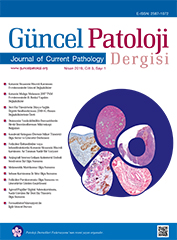Güncel Patoloji Dergisi
2019, Cilt 3, Sayı 1
Direct Immunofluorescence Microscopy Findings of Autoimmune Vesiculobullous Dermatitis
1 Dokuz Eylül Üniversitesi Tıp Fakültesi, Patoloji Anabilim Dalı, İZMİR
DOI : 10.5146/jcpath.2019.39 Autoimmune vesiculobullous dermatitis are heterogeneous diseases characterized by antibodies to adhesion molecules of the skin and mucous membranes. The definitive diagnosis of early disease and making the differential diagnosis is extremely important in terms of treatment and prognosis of the patients. The definitive diagnosis is made by clinical findings, histopathological examination of the lesion, immunofluorescence microscopy and serology. DIF microscopy, which has been studied from a biopsy specimen taken from the perilesional area, despite the various advantages of serological diagnosis, remains a diagnostic gold standard with 98% specificity and 82-91% sensitivity. It is essential to have a dermoepidermal junction or interphase intact, and biopsy from bullous perilesional skin area for DIF examination. Only light microscopic findings are not sufficient and direct immunofluorescence microscopy should be added for the definitive diagnosis of autoimmune blistering disease. In this review, direct immunofluorescence findings of autoimmune vesiculobullous disease will be reviewed with clinical and histopathological findings. Anahtar Kelimeler : Autoimmune vesiculobullous dermatitis, Pemphigus, Pemphigoid, Dermatitis herpetiformis, Direct immunofluorescence
DOI : 10.5146/jcpath.2019.39 Autoimmune vesiculobullous dermatitis are heterogeneous diseases characterized by antibodies to adhesion molecules of the skin and mucous membranes. The definitive diagnosis of early disease and making the differential diagnosis is extremely important in terms of treatment and prognosis of the patients. The definitive diagnosis is made by clinical findings, histopathological examination of the lesion, immunofluorescence microscopy and serology. DIF microscopy, which has been studied from a biopsy specimen taken from the perilesional area, despite the various advantages of serological diagnosis, remains a diagnostic gold standard with 98% specificity and 82-91% sensitivity. It is essential to have a dermoepidermal junction or interphase intact, and biopsy from bullous perilesional skin area for DIF examination. Only light microscopic findings are not sufficient and direct immunofluorescence microscopy should be added for the definitive diagnosis of autoimmune blistering disease. In this review, direct immunofluorescence findings of autoimmune vesiculobullous disease will be reviewed with clinical and histopathological findings. Anahtar Kelimeler : Autoimmune vesiculobullous dermatitis, Pemphigus, Pemphigoid, Dermatitis herpetiformis, Direct immunofluorescence


